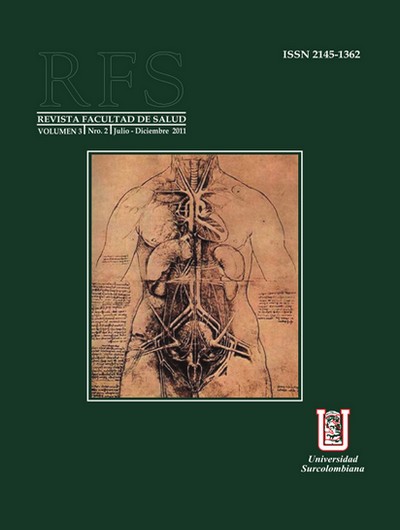Prevalence and risk factors related to bleeding of patients when undergoing warfarina therapy at Hernando Moncaleano Perdomo Hospital in Neiva in 2011
##plugins.themes.bootstrap3.article.main##
This research aims at determining bleeding prevalence as Walfarina use complication and related risk factors in adult patients at Hernando Moncaleano Perdomo University Hospital in Neiva. (HMPUH). It is a retrospective period cross-sectional study from 2011, carried out with 67 patients from HMPUH, showing a INR prolongation (INR>3) and Warfarina intake, overanticoagulation diagnose and/or bleeding presence when taking Warfarina. Data analysis was carried out with epi Info v.7.0. and Microsoft Office Excel 14.0.0. A bleeding prevalence related to anticoagulation was found during 2011. It was of 59.70%, being the highest bleeding (62,50%), the most frequent. Main diagnoses having indication of anticoagulation were: mechanical valve prostheses (31, 34%), venous thromboembolism (29,85%), and auricular fibrillation (16,42%). No relation was found between kind of indication and bleeding presence. 75,12% of patients had drug interaction mainly with Lovastatina (35,82%), Omeprazol (28,36%) and Acetaminophen (25,37%). There were 4 deaths (5, 97%) during the study, 2 (5%) fatal bleeding. Statistically significant factors were adequate control, possible protective factor for bleeding presence and being woman, possible risk factor for showing major bleeding. In conclusion, there is high prevalence of bleeding among anticoagulated patients. This study suggests as possible risk factor (3 times higher) in the presence of major bleeding, belonging to female gender and as possible protective factor, being man and keep adequate control; besides bleeding may take place no matter INR.
Downloads
##plugins.themes.bootstrap3.article.details##
HafnerJW,Belknap SM, SquillanteMD, BucheitKA. (200). Adverse drug eventsin emergency department. Ann Emerg Med, 39(3): 258-266.
Budnitz DS, Pollock DA, Mendelsohn AB, Weidenbach KN, McDonald AK, An- nest JL. (2005). Emergency department visits for outpatient adverse drug events: demonstration for a national surveillance system. Ann Emerg Med, 45(2):197-206.
Budnitz DS, Pollock DA, Weidenbach KN, Mendelsohn AB, Schroeder TJ, An nest JL. National surveillance of emergency department visits for outpatient adverse drug events. JAMA. 2006;296(15):1858-1866
Schulman S. (2003). Care of Patients receiving long-Term anticoagulant Therapy. N Eng J Med, 349:675-8.
McMahan DA, Smith DM, Carey MA, Zhou XH. (1998). The risk of major hemorrhage for outpatients treated with warfarin. J Gen Intern Med, 13:311-6
Tribiño G, Maldonado C, Segura O, Díaz J. (2006). Costos directos y aspectos clínicos de las reacciones adversas a medicamentos en pacientes hospitalizados en el servicio de medicina interna de una institución de tercer nivel de Bogotá. Biomédica, 26:31-41
Fihn SD, McDonell M, Martin D, et al. (1993). Risk factor for complications of chronic anticoagulation, a multicenter study; warfarin optimized out patient follow-up study group. Ann InternMed, 118:511-520.
Da Silva MS, Sobel M. (2002). Anticoagulants: to bleed or not to bleed, that is the question. SeminVascSurg, 15(4):256-267.
LINDH Jonatan D., HOLM Lennart, DAHL Marja-Liisa, ALFREDSSON Lars, RANE Anders. (2008). J ThrombThrombolysis, 25: 151-159, DOI 10.1007/s11239-007-0048-2.
Newman DH, Zhitomirsky I. (2006). The Prevalence of Nonthe- rapeutic and Dangerous International Normalized Ratios Among Patients Receiving Warfarin in the Emergency Department. Ann EmergMed, 48: 182-189.
Pineda Ruiz JC. (2009). Sobranticoagulación con Warfarina. Archivos de medicina, Manizales, 9(2):174-182.
Builes CE, Arango Cano WC. (2010). Frecuencia de sangrado en pacientes con enfermedades cardiovasculares anticoagulados con warfarina genérica vs. Coumadin. Acta Médica colombiana, 35(4):175-178.










